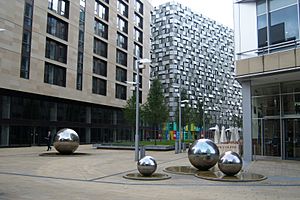Millennium Square, Sheffield facts for kids
Millennium Square is a cool, modern public space in Sheffield, England. It was built as part of a big plan called the "Heart of the City" project, which started in 1998. This project helped make Sheffield's city centre look new and exciting.
The square has special fountains shaped like shiny steel balls. These remind everyone of Sheffield's history as a place famous for making steel. The fountains also connect to other water features nearby, like those in the Peace Gardens, Sheaf Square, Hallam Square, and Barkers Pool. Millennium Square is part of a special path called the 'Gold Route'. This path helps visitors find their way through the city centre, from Sheffield Station all the way to Devonshire Green.
Before Millennium Square was built, an older building called the Town Hall Extension stood there. This building was put up in the 1970s. It was taken down in the early 2000s to make room for all the new buildings and spaces in the "Heart of the City" project.
Even though it's called a "square," Millennium Square is actually shaped like a triangle! It was designed by architects named Allies and Morrison. New buildings surround three sides of the square. On the fourth side, you'll find the beautiful Peace Gardens, which were also updated.
The ground of the square is made from a strong concrete base. On top of this, there are pretty paving stones made of granite and sandstone. Hundreds of tiny LED lights are hidden in the ground. These lights make the square glow at night, lighting up both the paving and the cool steel water features.
Millennium Square helps connect different parts of the city. It links the Winter Gardens and Peace Gardens. It also connects to the St Paul's Place area. This area is home to St Pauls Tower, which is the tallest building in Sheffield. The square is surrounded by either brand-new buildings or older ones that have been updated.
Water Features: The Steel Balls
The square has nine special steel balls that are actually water features. These were designed by an artist named Colin Rose. He won a competition in 2003 to create them.
What the Water Features Mean
Colin Rose designed the steel balls to show important parts of Sheffield's past. They stand for:
- Steel: Sheffield's famous steel-making history.
- Craftsmanship: The skill of local workers.
- Stonework: The buildings made from stone.
- Water: The rivers and rain in the area.
The whole artwork is called ‘Rain’. It's meant to look like raindrops falling onto the ground. The small pools at the bottom of each steel ball create a ripple effect, just like when a raindrop hits water.



